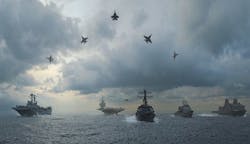Transforming ocean warfare using networked systems of systems (SoS) for wide-area sea control
Officials of the U.S. Defense Advanced Research Projects Agency (DARPA) in Arlington, Va., issued a broad agency announcement Monday for the Cross Domain Maritime Surveillance and Targeting (CDMaST) Phase 2 project.
CDMaST seeks to develop the ability to target enemy forces above, on, and under the ocean to hold enemy ships and submarines at risk over wide contested areas.
The objective is not to develop a specific technology but to develop and demonstrate a new warfighting concept. DARPA officials say they are trying to transform the future of sea control with a new maritime SoS warfighting concept.
Related: DARPA seeks to develop non-lethal weapons and sensors that pop up from the ocean's depths
The effort will new applications and technologies in communications; battle management; command and control (C2); position, navigation, and timing (PNT); logistics; sensors; manned and unmanned systems; and weapons.
U.S. sea-control today involves carrier battle groups and high-end nuclear submarines. Yet depending on these assets is increasingly difficult because of numerous enemy long-range anti-ship missiles. Adversaries also are increasing their fixed and mobile anti-submarine capabilities.
The CDMaST program seeks to move away from a centralized defensive battle group posture to a more distributed and agile approach to hold the opponent at risk over ocean areas as large as a million square kilometers.
The concept is to distribute combat ability across many low-cost systems to threaten the opponent and force him on defense. This will involve a combination of manned and unmanned systems to form an SoS architecture that is able to conduct wide area surveillance and targeting. CDMaST implementation must cause the opponent to expend resources trying to defeat the low-cost systems.
DARPA researchers are considering networked systems of new anti-ship missiles; fast, long-range undersea weapon systems; unmanned, long-endurance air, surface, and undersea vehicles; and prepositioned seafloor systems. Combined with manned platforms, these systems can provide the surveillance and targeting needed to exploit new weapons.
The CDMaST Phase 2 project will focus on an anti-submarine warfare (ASW) scenario, and will include anti-surface warfare (ASuW) to support an integrated ASuW/ASW scenario.
An award for this second phase of the CDMaST will go to only one contractor. Proposals are due to DARPA by 1 Nov. 2017, although the agency will accept proposals until 10 March 2018. Email questions or concerns to DARPA at [email protected].
More information is online at https://www.fbo.gov/spg/ODA/DARPA/CMO/HR001117S0046/listing.html.
Learn more: search the Aerospace & Defense Buyer's Guide for companies, new products, press releases, and videos
